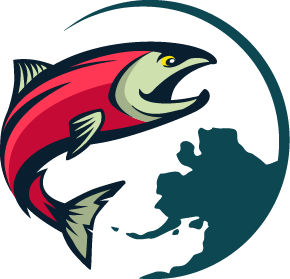SALMON WATCHERS
I live in Sitka, on the southeast Alaska coast. And every summer one of the earth’s greatest natural spectacles happens just down the road. From July to October, up to a million salmon crowd into the clear, chill waters of Indian River.
There’s a lovely wooden footbridge that arches across the river in Sitka National Historic Park. It’s a perfect place to watch the salmon thronging upstream, skittering across the riffles, staking out territories, going through their rituals of courtship and spawning.
Between 150,000 and 300,000 people visit the park each year — mostly tourists from the cruise ships and ferries, along with the daily contingent of locals. Almost everyone stops on the bridge to peer down at the fish, arrayed side by side, heads pointed upstream, densely covering the bright gravel bottom.
One day at the peak of this year’s run, I head for the park to spend a few hours mingling with groups of visitors on the bridge.
Almost immediately, I notice an older guy decked out in a bright red “Ohio Buckeyes” sweatshirt. When he spots the dark mass of salmon, his eyes widen and he instantly abandons his wife, rushing ahead through the crowd. At the top of the bridge he leans out over the railing, opens his arms wide to the river, and bellows: “Man, look at that! There’s a zillion of ’em down there!”
I can’t help breaking into a wide smile as his words ring away through the forest.
A woman standing nearby is no less amazed but a lot more subtle. She keeps shaking her head and whispering: “I just can’t believe it. They’re so beautiful. And to think, they’re all here to lay eggs!”
I visit the bridge almost daily in the salmon season, and I’m always torn between watching the fish and watching the people.
Some of the crowds are noisy, everyone raising their voices to be heard above the chatter and ruckus. Other groups are hushed and reverent, like participants in a solemn ceremony.
I love talking with folks on the bridge, and if they find out I live in Sitka there’s usually a barrage of questions.
First the basic stuff: What kind of salmon are these? How much do they weigh? Are they different from the (Atlantic) salmon released into the Great Lakes?
Then more detailed curiosities: How long have these fish been out in the ocean? How did they find their way back? How far do they go up the river? Do people catch and eat salmon after they’re in the stream?
And of course, the facts of life: Can you tell males from females? Where do they lay the eggs? How are the eggs fertilized? When do they hatch? How long will these fish live after they spawn?
My partner in SalmonWorld Liz McKenzie, overheard a European tourist imploring: “Somebody needs to tell us. Why are they all just lying around?”
But if there’s a classic Indian River bridge commentary, it’s this one by a gentleman from Pennsylvania: “I mean, I’ve always heard about this, but I had no idea that seeing it would be so…amazing!”
That’s the magic word: “Amazing.” Sometimes whispered, sometimes declared to a friend or spouse, sometimes exclaimed loudly and repeatedly to everyone who might be listening. Or to no one at all.
Later in the season, when the riverbanks are lined with dead and dying fish, the comments often get more philosophical.
“Hard to imagine all the work they’ve done to get here,” one man concludes. And the woman beside him adds, “They’ve used up all their energy and now they have nothing left to give.”
Somebody wonders out loud, “How can anyone not think this is all part of God’s design?”
But another watcher seems more scientifically inclined. As two big male chum salmon fight over the closest spot to a female digging her redd, or nest, he declares: “It’s always competition isn’t it. The strongest ones survive and pass on their genes. Then they all die and feed everything else.”
Of course, the philosophy doesn’t always run so deep. A guy wearing an L.A. Dodgers ball cap sees one salmon briefly turn downstream, then announces to all within earshot:
“Oh yeah, he’s thinking, ‘Hey, I don’t wanna die! I’m outa here…back to the ocean!”
When I watch salmon late in the season — their living bodies covered with decay, sometimes swimming aimlessly or upside down, sometimes lying inert in the shallows with their gills still pumping — one question always lurks in my mind: Are these doomed fish suffering?
I’m comforted by knowing that they die fairly quickly. And above all by the knowledge that this amazing event makes visible the brilliant and beautiful process of life. One generation passing itself to the next.
No one will ever again see a sky filled with passenger pigeons or a prairie covered horizon to horizon with buffalo; but here in Alaska we still have the salmon. And by caring for all that sustains these remarkable fish, we can pass this rich legacy to our own future generations.
Alone on the bridge in November, I can still hear the voices of last summer’s salmon watchers — exuberant, curious, fascinated, astonished. In a time when so much of nature is in retreat, it elevates our souls to witness such abundance and to experience the world as it should be — undiminished, uncompromised, surging with pure wild energy.
By Richard Nelson for SalmonWorld

